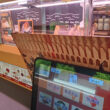In Japan, rice prices have jumped by 30% to 50% compared to last year, prompting many consumers to seek more affordable alternatives. Udon noodles have become a popular choice, and restaurants like Matsuya and Yoshinoya, which offer free rice refills, are seeing increased patronage from those looking to cut dining costs.
TOKYO, JAPAN (Business Northeast) – Despite the arrival of new rice from the 2024 harvest in supermarkets, prices remain 30% to 50% higher than the previous year’s crop. This significant rise in rice prices is impacting daily food budgets, leading home cooks to reduce their rice consumption and explore other options. Udon noodles are gaining traction as a cost-effective substitute, and the free rice refills at Matsuya and Yoshinoya are making these restaurants popular among budget-conscious diners.
To understand the public’s reaction to the increase in rice prices, shopping information service company Loco Guide Co., Ltd. conducted a survey on “rice shortage” among 12,816 users and found that people are actively looking for rice suppliers and choosing other alternative ingredients to fill their rice shortages, and started using other ingredients instead of rice. According to the survey, more than 50% of the respondents stated that “udon” is the most common substitute for rice. Next are “pasta” (42.2%), “plain noodles” (40.2%) and “bread” (39.5%).
During the interview, Mrs. Sato, who purchases ingredients in the supermarket, said that although the supermarket has resumed selling rice, the price has increased too much, and she can only buy small packages. To save money, rice can only be replaced with pasta. For example, breakfast is changed to bread or toast, and rice in lunch boxes is replaced by pasta. It is hoped that rice prices will return to regular prices as soon as possible.

In addition to home cooks starting to adjust the types of meals they offer, dine-in eaters are also looking for restaurants where rice is free or extra portions do not increase the price. Gyudon chain restaurants Matsuya and Yoshinoya are widely popular in Japan. They provide rich rice and attract people who eat out. Matsuya Food has started to provide rice cooked with this year’s new rice and continues to provide “free rice refills” service. The regular-size beef rice in the store is 430 yen (tax included), and you can enjoy an unlimited supply with just one coin. Delicious white rice has become one of the first choices for eating out.
In addition, Yoshinoya also offers free refills of the rice in the set meal. The beef platter set is generally priced at 648 yen (712 yen, including tax). Although the price is slightly higher than Matsuya’s, the set meal has a wider variety of dishes and has opened many stores overseas, becoming a favorite restaurant among consumers in Japan and abroad. Mr. Chou, a Taiwanese tourist who dined at Yoshinoya, said: I love eating Japanese white rice; the set meal offers free refills so I will eat more rice bowls. Japanese white rice is indeed more delicious. I will also buy Koshihikari rice in Taiwan and cook it in a Japanese ZOJIRUSHI electronic pot. The aroma and taste of rice cooked with Japanese rice are number one in my heart.
Experts from the Japan Research Institute predict that when the new rice is expected to be fully circulated at the end of this month, the shortage problem should be improved, and the abnormally high prices should subside. However, due to increased production costs such as fertilizer and fuel, price increases are inevitable and may still be 10% higher than last year.










